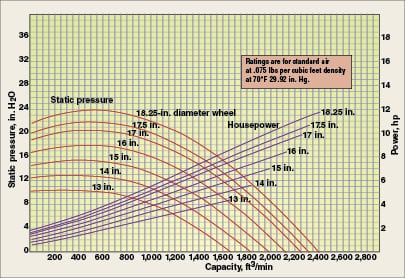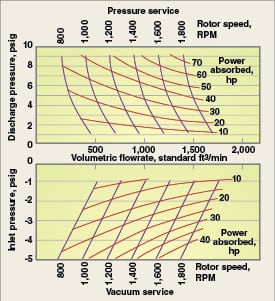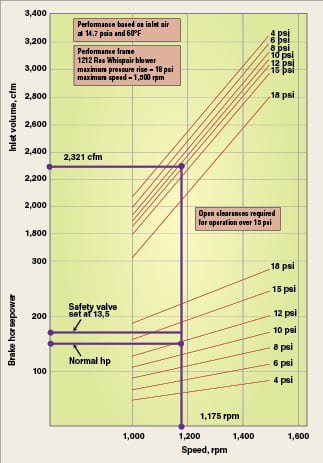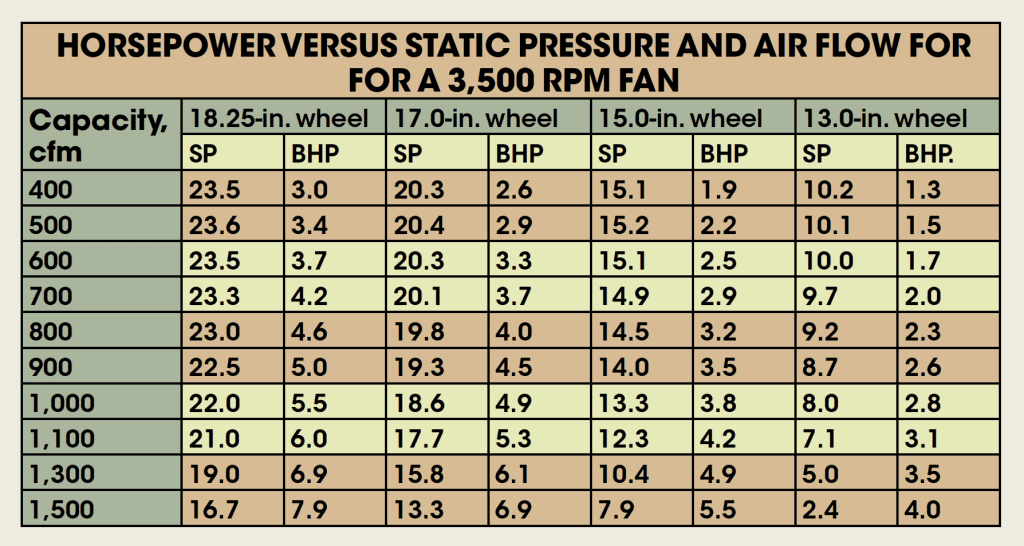Dilute-phase conveying systems generally use centrifugal fans and positive displacement blowers for supplying conveying air to the conveying system. However, for some conveying systems, compressed air from a central compressor station is also used. The two important criteria required for pneumatic conveying are air flow and air delivery pressure. Different air movers have different characteristics in the relationship between these two important criteria. Selection of an air mover is based on this relationship.
Fans
Fans are generally used for low-pressure conveying systems where the conveying pressure is less than 2 psig or where both low pressures and large air flows are required. Fans that are used in these cases are mostly of the centrifugal type. Their main disadvantage is a relatively steep sloping performance curve, wherein even a small change in discharge pressure results in a significant change in air volume delivered.
Fans operate by imparting movement to air as it passes though the unit. The kinetic energy of the moving air is converted into static pressure when the airflow is restricted. A fan’s volumetric output depends upon its discharge pressure. This output decreases as the pressure increases and increases as the pressure decreases. Because of this inverse relationship and a sharp sloping performance curve, fans are not positive displacement machines, and their output air volume changes with a change in discharge pressure.
The best application of fans is a system in which conveying conditions (such as conveying rate, distance and material type) are relatively constant parameters, and the resulting conveying system pressure is not expected to change much. Figure 1 shows typical performance curves for fans with different sizes of impeller diameters. The below table gives air flows at various static pressures and the resulting motor horsepower.

Operating characteristics
1. Airflow reduces as air pressure increases. Air flow stops when the conveying line plugs.
2. Horsepower reduces as air pressure increases.
3. Fans are unloaded by closing either the inlet or the outlet port.
4. Fans are mostly used in applications that require high air volume at low pressures.
Advantages of fans
• Low cost
• No close clearances
• Relatively low noise level
Blowers
Blowers for dilute-phase pneumatic conveying systems are generally rotary, positive displacement, lobe type blowers. They deliver oil-free air at pressures up to 18 psig.
Figure 2 shows the operating principle of these blowers. The blower has two rotors that are mounted on two parallel shafts within the blower housing. These rotors rotate in opposite directions, and as they rotate, air is drawn into the space between them and the housing wall. This air is trapped between the rotors and the housing, and with rotation of the rotors the air is transferred from the blower inlet to the blower outlet without compression. This trapped air flows into the conveying line. If the conveying line air pressure is higher than the blower suction pressure, this trapped air mixes with the conveying line air and gets compressed to the conveying air pressure. These blowers do not generate any pressure. However, they withstand the pressure in the conveying line up to their pressure rating.

The position of the two rotors relative to each other is maintained by timing gears installed on the two shafts in a separate housing. This allows operation of the rotors without any lubrication.
These blowers are called positive displacement type because they deliver a constant volumetric air flow regardless of the discharge pressure. There is a small leakage flow (about 1–2%) called “slip” from rotor outlet to rotor inlet because of the narrow clearances between the rotors and the casing.
Compression ratio of these blowers is about 2 to 1, which means that if the inlet air is at 14.7 psia pressure, blower can handle discharge pressures up to two times 14.7 psia, or about 15 psig. With special timing gear design, some vendors can increase this rating to 18 psig. Vacuum rating of these blowers is in the range of 15 in. Hg, but with special designs, it can increase to 18 in. Hg.
Volumetric capacity of these blowers is from very small to very large. Capacity is directly related to blower speed. Figure 3 shows the relationship between flow, pressure and horsepower.
Maximum speed of the blowers has an upper limit because of the maximum allowable tip speed of about 4,500 ft/min of the timing gears.

Sizing and selection
The various steps in sizing and selecting a blower for a conveying system are given below:
Blower volumetric flow: From the pneumatic-conveying-system calculations, determine the actual cubic feet per minute (ACFM) of the air that is required to convey the solids. This flow will be equal to the conveying velocity (ft/min) multiplied by the cross-sectional area of the pipe (ft2) at the pick-up point.
For pressure-type systems, calculate the volumetric flowrate of air that is lost through rotary valves. Estimate any loss of air through pipeline components, such as diverter valves, flexible hoses, pipe couplings an so on.
Add these losses to the conveying air flow. Add to this the blower slip flow. Calculate blower slip flow using vendor data and add this flow to the conveying air flow. This will give the total volumetric flowrate of air at the blower inlet. Use this flow for sizing the blower.
For vacuum type conveying systems, find out the total leakage into the conveying line (from rotary valves, diverter valves, flexible hoses, pipe line joints, and so on) and add this leakage to the calculated volumetric flow required for conveying. Then add to it the blower slip flow from outlet to inlet. Use this result to size the blower.
Conveying system design pressure: Use the following factors to determine the maximum design pressure for the conveying system:
• Pressure rating of the conveying blower
• Set point of the blower pressure safety valve (PSV) that protects the blower against over-pressure
• Pressure variations during actual operation of the conveying system
• Allowance for use of any empirical data in the calculations
Pressure rating of the blowers is generally 15 psig. Blower safety valve is then set at 15 psig.
Pressure drop in a conveying system can vary due to various reasons and can be assumed to be at least ±10% in a well-designed system. On this basis, the maximum design pressure will then be 0.9 3 15.0 = 13.5 psig.
To prevent the PSV from popping open due to pressure excursions, the setpoint of the PSV should be 13.5 psig. Conveying-system design pressure will be 10% below the PSV setting. This pressure will then be = 0.9 3 13.5 = 12.15 psig.
Use a 10% allowance for any errors in the data that is used in the calculations. With this allowance, the maximum design pressure comes to 0.9 3 12.15, or about 11 psig. On the above basis, conveying system design pressure should not exceed 11 psig.
Blowers are normally selected so that they operate at about the mid-point of their performance curves. Therefore, for a 15-psig maximum rating, the operating pressure should be about 7.5 psig. This gives a pressure drop range of 7.5 to 11 psi for the design of the conveying system. A lower pressure will require a larger diameter pipeline and a smaller blower. A higher pressure will require a smaller diameter pipeline and a larger blower. A good approach is to design a system about midway between these two options.
Blower discharge pressure (pressure-type conveying systems): From the pneumatic conveying calculations, determine the pressure drop in the conveying line. Then calculate the pressure drop for the flow of air in the pipeline between the blower and the solids’ pick-up point. Determine the pressure drop in all blower accessories, such as air filters, silencers and coolers. Then determine the pressure drop at the end of the conveying line such as in bin vent filters and dust collectors, and add it to the conveying line pressure drop. This will give the total pressure at blower discharge ( P 2).
Blower inlet pressure and temperature: Blower inlet pressure ( P 1) will be the sum of the ambient pressure and pressure drops in equipment such as blower inlet filter and blower inlet silencer. From ambient conditions, find out the ambient pressure and ambient temperature ( t 1,°C).
Required volumetric flowrate at blower inlet: Assuming adiabatic compression, calculate the volumetric flowrate of air (or gas) at the blower inlet ( V 1), as follows:
![]() (1)
(1)
Where:
K = Ratio of specific heats at constant pressure and volume ( C p/ C v) for conveying air or gas (1.4 for air)
V 2= Volumetric flowrate of air required by the conveying system (volumetric air flow at blower outlet)
P 2 = Blower discharge pressure, psia
P 1 = Blower inlet pressure, psia
Note: In Equation (1), the value of V 1 is derived from conveying system calculations, not from an actual blower size based on its manufacturing data. Since blowers are made in different sizes, use vendor data to find a blower whose inlet volumetric flow in cubic feet per revolution (CFR) multiplied by blower speed in revolutions per minute (N, rpm) comes closest to the blower inlet volume, V1, calculated in Equation (1).
V 1(based on actual blower size, ft3/min) = CFR 3 N (2)
Use this value of V 1in Equation (3).
Blower horsepower (HP): Calculate the blower horsepower as follows. First, find out the gas horsepower ( GHP):
 (2)
(2)
Where:
P 1 and P 2 are in lb/ft2
V 1 is in ft3/min [from Equation (2) not Equation (1)]
To determine the value of motor horsepower, the value of GHP is increased by the following allowances:
1. Conveying system pressure fluctuations of ±10% during operation. These can increase the motor load by 10%
2. An allowance of 10% for use of any empirical data in conveying system calculations
3. The resulting brake horsepower (bhp) is rounded off to match the hp rating of an available motor. This will give the blower motor horsepower.
Blower discharge temperature (t2): Assuming adiabatic compression, blower discharge temperature is determined as follows:
 (4)
(4)
Where:
T 2 = Blower discharge temperature, degrees Kelvin
t1 = Blower inlet temperature, °C
t2 = Blower discharge temperature, °C
P 2 = Blower discharge pressure, psia
P 1 = Blower suction pressure, psia
K = Ratio of specific heats (1.4 for air)
t 2 = T 2 – 273, °C(5)
( t is in degrees C, T is in Kelvin)
Blower selection: Use manufacturers’ catalogs to find a blower that will meet the above requirements of flow and pressure (Figure 4).

Consider the following example:
• Let the inlet flow ( V 1) = 2,321 cfm, at blower suction conditions.
• Let the blower discharge pressure ( P 2) = 12 psig.
Then, using the catalog for a Roots blower, select the blower with designation “Frame 1212 RAS Whispair” (Figure 4).
In this curve, draw a horizontal line from between 2,321 cfm, and the curve for 12 psi. From the intersection point at 12 psi, go vertically down to the blower speed line. Blower speed comes to 1,175 rpm and motor horsepower comes to 150 hp.
Blower drive motor: Determine the setting of the safety valve at the blower discharge. This should be 10–15% above the maximum operating pressure. In the blower curve, read the horsepower at the higher discharge pressure (safety valve setting). Select motor horsepower accordingly.
Typical drive methods for blowers:
•For blowers up to 200 hp, use V belt drives
•For blowers from 200 to 400 hp, use a gear reducer
•For blowers above 400 hp, use direct drive
Note: Use manufacturer’s recommendation in all cases.
Blower noise level: Silencers will be required to reduce blower’s noise level. A noise level of 85 dbA is possible with well-designed silencers but full acoustic enclosures around the blower are required to achieve 80 dbA.
Major blower selection criteria
Major criteria for blower selection are given below.
1. Positive displacement: Blower is to be positive displacement, twin lobe type. Three lobes can be used as an option.
2. Oil free: Blower is to be oil free type. In other words, oil used to lubricate the gears should not enter the rotor housing.
3. Operate at middle of operating range: Blower selected should operate close to the middle of its operating range. Always obtain the blower performance curve from its vendor. This curve will show volumetric flow versus blower pressure at various blower speeds.
4. Optimum speed: The blower should operate at about 1,800 rpm.
5. Aim for high volumetric efficiency: Use the highest possible volumetric efficiency (lowest slip) by selecting a blower with minimum clearances between the rotors and the housing.
6. Aim for high mechanical efficiency: Select a drive that has high mechanical efficiency.
7. Low pressure-drop inlet filter: Inlet filter should be of the low pressure-drop type (less than 1 in. H2O) and should be easily replaceable.
8. Materials of construction and lubrication: The standard materials of construction are cast and forged steel. Bearings are lubricated either by slinger rings or with forced lubrication. Shaft seals are usually labyrinth or piston ring type with lip-type oil seals.
9. Package details: Blowers usually are bought as a package including blower, drive motor, silencers and filters. For sizes under 200 hp use a belt drive because it permits easy speed changes if needed. Sizes over 200 hp are usually gear driven. Larger sizes are generally driven directly from a drive motor but this method prevents blower speed change if found necessary. Blowers are inherently very noisy; therefore, silencers are generally required to meet acceptable noise standards. Even with the silencers, the noise level may still be high, and additional acoustical protection, such as sound enclosures, may be required.
10. Inlet filters are installed on the inlet or suction line of pressure blowers to keep atmospheric dust or other air-borne materials out of the process and from getting into the blower: On vacuum systems, the inlet filter is installed at the beginning of the conveying line upstream of the solids injection point. The better quality inlet filters are pleated polyester or polyethylene felt backed by stainless steel wire mesh for support and designed for easy cleaning and reuse. Some filters are pleated paper similar to an automobile air cleaner, and others are loose fiberglass in sheet metal housing similar to household furnace filters. These are the “throw-away” kind of filters. Although any of these materials are acceptable in this service, the pleated felt is preferred because it removes nearly all particles under a few microns in size.
Inlet filters are sized for an air to filter ratio between 30:1 to 50:1 based on actual cfm of air per square foot of filter area. The pressure drop across the filter should be less than 1 in. H2O.
11. In-line filters: Sometimes, an in-line filter is used in the blower discharge line before the solids feed point to remove any pipe scale or rust from entering the conveying line. Another approach to in-line filtration is to use a non-scaling or non-rusting material of construction such as stainless steel, or aluminum for the filter housing and the silencers.
In-line filters are usually “cord-wound” cones, felt cones or pleated felt. The filter elements are enclosed in a cylindrical vessel with a pressure rating compatible with the maximum blower pressure. The filter elements are usually the disposable type and are sized on the same basis as the inlet filters — that is between 30:1 and 50:1 of air-to-media area ratio.
12. Air coolers: Air coolers are required in most pressure type conveying systems when the blower discharge temperature is 80*C or above. Some materials, such as plastics, are heat sensitive and generate more fines and dust at high temperatures.
Air coolers used in conveying systems are of a standard design. They are usually constructed of several “banks” of finned copper tubes that are very similar to an automobile radiator enclosed in aluminum or stainless steel housing. Both air-cooled and water-cooled exchangers are acceptable. However, use a low-pressure drop cooler such as a straight flow type.
In some operating situations, such as relatively low cooling-water temperature and warm, moist air, water may condense on the air-side of the cooler. The air velocity on the shell side of the cooler is low enough to de-entrain this condensed water and allow it to collect at the low point of the cooler shell. Where this is likely to occur, the cooler should be placed in a horizontal run of pipe and a drain valve provided at the low point of the shell. An automatic drain should be provided if the problem is severe.
Blower instrumentation
The following instrumentation and controls are necessary for troublefree operation of th conveying system:
• A pressure gage and a pressure transmitter at the blower discharge to monitor blower operating pressure and to automatically shut down the solids feed if pressure becomes too high
• A temperature gage at the blower discharge to monitor blower discharge temperature
Compressors
Compressors are required for high-pressure pneumatic conveying, such as dense phase conveying. Dedicated compressors are not used for dilute phase conveying because their high pressures are not required for these systems. However, if a central compressed air system is available, and the cost of compressed air can be justified, this air can be used for dilute-phase conveying systems. To use this compressed air, use a pressure control valve to reduce the conveying pressure and a flow control valve to regulate the air flow.
Edited by Rebekkah Marshall
Author

Amrit Agarwal is a consulting engineer with Pneumatic Conveying Consultants (7 Carriage Road, Charleston, WV, 25314; Phone: 304-553-1350, Email: [email protected]). He started his consulting work after retiring from Dow Chemical Co. in 2002 as a senior research specialist. He has more than 47 years of design and operating experience in bulk solids handling and pneumatic conveying. He holds an M.S. in mechanical engineering from the University of Wisconsin-Madison, and an M.B.A. from the West Virginia College of Graduate Studies in Charleston.
